Related Research Articles

Infrared astronomy is the branch of astronomy and astrophysics that studies astronomical objects visible in infrared (IR) radiation. The wavelength of infrared light ranges from 0.75 to 300 micrometers. Infrared falls in between visible radiation, which ranges from 380 to 750 nanometers, and submillimeter waves.

The Terrestrial Planet Finder (TPF) was a proposed project by NASA to construct a system of space telescopes for detecting extrasolar terrestrial planets. TPF was postponed several times and finally cancelled in 2011. There were two telescope systems under consideration, the TPF-I, which had several small telescopes, and TPF-C, which used one large telescope.

The Spitzer Space Telescope, formerly the Space Infrared Telescope Facility (SIRTF), is a retired infrared space telescope launched in 2003 and retired on 30 January 2020.

Venus Express (VEX) was the first Venus exploration mission of the European Space Agency (ESA). Launched in November 2005, it arrived at Venus in April 2006 and began continuously sending back science data from its polar orbit around Venus. Equipped with seven scientific instruments, the main objective of the mission was the long term observation of the Venusian atmosphere. The observation over such long periods of time had never been done in previous missions to Venus, and was key to a better understanding of the atmospheric dynamics. It was hoped that such studies can contribute to an understanding of atmospheric dynamics in general, while also contributing to an understanding of climate change on Earth. ESA concluded the mission in December 2014.

The Herschel Space Observatory was a space observatory built and operated by the European Space Agency (ESA). It was active from 2009 to 2013, and was the largest infrared telescope ever launched, carrying a 3.5-metre (11.5 ft) mirror and instruments sensitive to the far infrared and submillimetre wavebands (55–672 µm). Herschel was the fourth and final cornerstone mission in the Horizon 2000 programme, following SOHO/Cluster II, XMM-Newton and Rosetta. NASA is a partner in the Herschel mission, with US participants contributing to the mission; providing mission-enabling instrument technology and sponsoring the NASA Herschel Science Center (NHSC) at the Infrared Processing and Analysis Center and the Herschel Data Search at the Infrared Science Archive.

Airglow is a faint emission of light by a planetary atmosphere. In the case of Earth's atmosphere, this optical phenomenon causes the night sky never to be completely dark, even after the effects of starlight and diffused sunlight from the far side are removed.
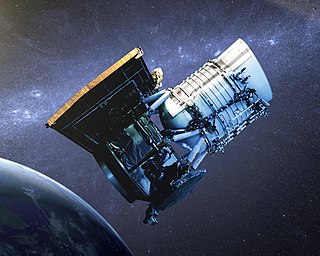
The Wide-field Infrared Survey Explorer is a NASA infrared-wavelength astronomical space telescope launched in December 2009, and placed in hibernation mode in February 2011. It was re-activated in 2013. WISE discovered thousands of minor planets and numerous star clusters. Its observations also supported the discovery of the first Y Dwarf and Earth trojan asteroid.
An extraterrestrial vortex is a vortex that occurs on planets and natural satellites other than Earth that have sufficient atmospheres. Most observed extraterrestrial vortices have been seen in large cyclones, or anticyclones. However, occasional dust storms have been known to produce vortices on Mars and Titan. Various spacecraft missions have recorded evidence of past and present extraterrestrial vortices. The largest extraterrestrial vortices are found on the gas giants, Jupiter and Saturn, and the ice giants, Uranus and Neptune.
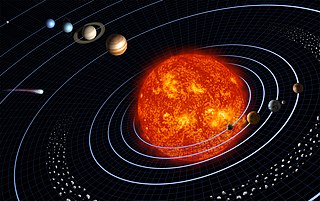
The study of extraterrestrial atmospheres is an active field of research, both as an aspect of astronomy and to gain insight into Earth's atmosphere. In addition to Earth, many of the other astronomical objects in the Solar System have atmospheres. These include all the gas giants, as well as Mars, Venus, Titan and Pluto. Several moons and other bodies also have atmospheres, as do comets and the Sun. There is evidence that extrasolar planets can have an atmosphere. Comparisons of these atmospheres to one another and to Earth's atmosphere broaden our basic understanding of atmospheric processes such as the greenhouse effect, aerosol and cloud physics, and atmospheric chemistry and dynamics.

PLAnetary Transits and Oscillations of stars (PLATO) is a space telescope under development by the European Space Agency for launch in 2026. The mission goals are to search for planetary transits across up to one million stars, and to discover and characterize rocky extrasolar planets around yellow dwarf stars, subgiant stars, and red dwarf stars. The emphasis of the mission is on earth-like planets in the habitable zone around sun-like stars where water can exist in liquid state. It is the third medium-class mission in ESA's Cosmic Vision programme and named after the influential Greek philosopher Plato. A secondary objective of the mission is to study stellar oscillations or seismic activity in stars to measure stellar masses and evolution and enabling the precise characterization of the planet host star, including its age.
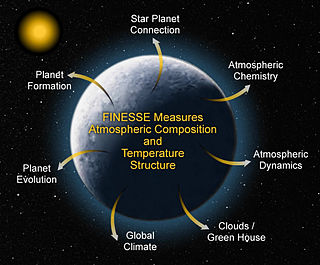
Fast Infrared Exoplanet Spectroscopy Survey Explorer (FINESSE) was a NASA mission proposal for a space observatory operating in the Near-infrared spectrum for the Medium-Class Explorers program. The Principal Investigator was Mark Swain of the Jet Propulsion Laboratory in Pasadena, California.
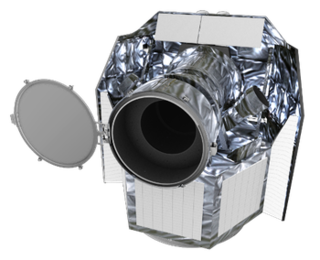
CHEOPS is a European space telescope. Its objective is to determine the size of known extrasolar planets, which will allow the estimation of their mass, density, composition and their formation. Launched on 18 December 2019, it is the first Small-class mission in ESA's Cosmic Vision science programme.
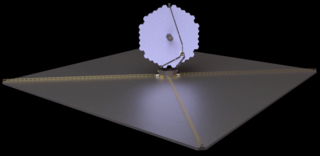
The Large Ultraviolet Optical Infrared Surveyor, commonly known as LUVOIR, is a multi-wavelength space telescope concept being developed by NASA under the leadership of a Science and Technology Definition Team. It is one of four large astrophysics space mission concepts being studied in preparation for the National Academy of Sciences 2020 Astronomy and Astrophysics Decadal Survey. While LUVOIR is a concept for a general-purpose observatory, it has the key science goal of characterizing a wide range of exoplanets, including those that might be habitable. An additional goal is to enable a broad range of astrophysics, from the reionization epoch, through galaxy formation and evolution, to star and planet formation. Powerful imaging and spectroscopy observations of Solar System bodies would also be possible. LUVOIR would be a Large Strategic Science Mission and will be considered for a development start sometime after 2020. The LUVOIR Study Team has produced designs for two variants of LUVOIR: one with a 15.1 m diameter telescope mirror (LUVOIR-A) and one with an 8 m diameter mirror (LUVOIR-B). LUVOIR can observe ultraviolet, visible, and near-infrared wavelengths of light. The Final Report on the 5-year LUVOIR mission concept study was publicly released on 26 August 2019.
The Habitable Exoplanet Imaging Mission (HabEx) is a space telescope concept that would be optimized to search for and image Earth-size habitable exoplanets in the habitable zones of their stars, where liquid water can exist. HabEx would aim to understand how common terrestrial worlds beyond the Solar System may be and the range of their characteristics. It would be an optical, UV and infrared telescope that would also use spectrographs to study planetary atmospheres and eclipse starlight with either an internal coronagraph or an external starshade.

Origins Space Telescope (Origins) is a concept study for a Far-Infrared Surveyor space telescope mission. A preliminary concept in pre-formulation, it was presented to the United States Decadal Survey in 2019 for a possible selection to NASA's large strategic science missions. Origins would provide an array of new tools for studying star formation and the energetics and physical state of the interstellar medium within the Milky Way using infrared radiation and new spectroscopic capabilities.

The Atmospheric Remote-sensing Infrared Exoplanet Large-survey (ARIEL), is a space telescope planned for launch in 2029 as the fourth medium-class mission of the European Space Agency's Cosmic Vision programme. The mission is aimed at observing at least 1000 known exoplanets using the transit method, studying and characterising the planets' chemical composition and thermal structures. Compared to the James Webb Space Telescope, ARIEL will have more observing time available for planet characterisation but a much smaller telescope and it will be launched almost a decade later.

Large Interferometer For Exoplanets (LIFE) is a project started in 2017 to develop the science, technology and a roadmap for a space mission to detect and characterize the atmospheres of dozens of warm, terrestrial extrasolar planets. The current plan is for a nulling interferometer operating in the mid-infrared consisting of several formation flying collector telescopes with a beam combiner spacecraft at their center.
References
- 1 2 "Darwin: study ended, no further activities planned". European Space Agency. 2009-10-23. Retrieved 2009-10-27.
- 1 2 3 Fridlund, CVM (August 2000). "ESA Bulletin 103: Darwin: The Infrared Space Interferometry Mission" (PDF). ESA. Retrieved 2016-11-07.
- ↑ "Darwin factsheet: Finding Earth-like planets". European Space Agency. 2009-10-23. Archived from the original on 2008-05-13. Retrieved 2009-10-27.
- ↑ Penny, Alan J (1999-07-27). "A concept for the 'Free-Flyer' version". Rutherford Appleton Laboratory. Archived from the original on 2005-10-28. Retrieved 2009-10-30.
- 1 2 Karlsson, Anders; Malcolm Fridlund (April 2002). "Darwin: The Infrared Space Interferometer". Alcatel. Archived from the original (GIF) on 2005-10-28. Retrieved 2009-10-30.
- ↑ von Bloh, W.; Bounama, C.; Cuntz, M.; Franck, S. (2007). "The Habitability of Super-Earths in Gliese 581". Astronomy & Astrophysics . 476 (3): 1365–1371. arXiv: 0705.3758 . Bibcode:2007A&A...476.1365V. doi:10.1051/0004-6361:20077939. S2CID 14475537.
- ↑ Science Daily: Extrasolar planet may indeed be habitable
- ↑ "NASA budget statement". Planetary Society. 2006-02-06. Retrieved 2006-07-17.
- ↑ NASA President's FY 2007 Budget Request


